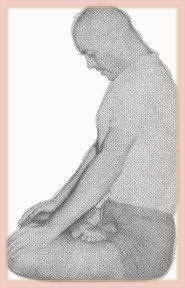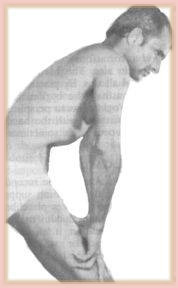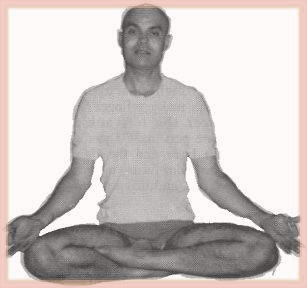|
Siddhasana
(The Perfect Pose)
|
|
| Next to
Padmasana comes Siddhasana in importance. Some eulogise this Asana as even
superior to Padmasana for the purpose of Dhyana (contemplation). If you get
mastery over this Asana you will acquire many Siddhis. Further, it was being
practiced by many Siddhas (perfected Yogins) of yore. Hence the name
Siddhasana.
|
|
|
|
| Even
fatty persons with big thighs can practise this Asana daily. In fact this is
better for some persons than Padmasana. Young Brahmacharins, who attempt to get
established in celibacy, should practise this Asana. This is not suitable for
ladies.
|
|
|
|
|
|
|
|
|
Technique
|
|
|
|
| Place
the left heel at the anus or Guda, the terminal opening of the alimentary canal
or digestive tube. Keep the right heel on the root of the generative organ, the
feet or legs should be so nicely arranged that the ankle-joints should touch
each other. Hands can be placed as in Padmasana.
|
|
|
|
Svastikasana
(Prosperous Pose)
|
|
|
|

|
Svastika is sitting
at ease with the body erect. Spread the legs forward. Fold the left leg and
place the foot near the right thigh muscles. Similarly, bend the right leg and
push the foot in the space between the thigh and calf muscles. Now you will
find the feet between the thighs and calves of the legs. This is very
comfortable for meditation. Keep the hands as instructed in Padmasana.
|
|
|
|
|
Samasana
(Equal Pose)
|
|
|
|
| Place
the left heel at the beginning of the right thigh and the right heel at the
beginning of the left thigh. Sit at ease. Do not bend either on the left or
right. This is called as Samasana.
|
|
|
|
Three
Bandhas
|
|
|
|
| There
are four Bhedas (piercing of divisions) viz., Surya, Ujjayi, Sitali and Basti.
Through these four ways, when Kumbhaka is near or about to be performed, the
sinless Yogi should practise the three Bandhas. The first is called Mula
Bandha. The second is called Uddiyana, and the third is Jalandhara. Their
nature will be thus described. Apana which has a downward tendency is forced up
by contracting and drawing the anus upwards. This process is called Mula
Bandha. When Apana is raised up and reaches the sphere of Agni (fire), then the
flame of Agni grows long, being blown about by Vayu. The Agni and Apana come to
or commingle with Prana in a heated state. Through this Agni, which is very
fiery arises in the body the flaming of fire which rouses the sleeping
Kundalini. Then the Kundalini makes a hissing noise, becomes erect like a
serpent beaten with a stick and enters into the hole of Brahmanadi (Sushumna).
Therefore Yogins should daily practise Mula Bandha. Uddiyana should be
performed at the end of Kumbhaka and at the beginning of inhalation. Because
Prana ‘Uddiyate’—goes up the Sushumna in this Bandha, it is called
Uddiyana by the Yogins. Being seated in the Vajra posture and holding firmly
the two toes by the two hands near the two ankles, he should gradually upbear
the Tana (thread or Nadi, the Sarasvati Nadi) which is on the western side of
Udara (the upper part of the abdomen, above the navel), then to neck. When
Prana reaches Sandhi (junction) of navel, slowly it removes the diseases of the
navel. Therefore this should be practised perfectly. Uddiyana can be done in
standing posture also. When you practise in standing posture, place your hands
on the knees or a little above the knees. Keep the legs a little apart.
|
|
|
|
| The
Bandha called Jalandhara should be practised at the end of Puraka. Jalandhara
is of the form of contraction of the neck and is an impediment to the passage
of Vayu upwards. When the neck is contracted by bending the head downwards, so
that the chin may touch the chest, Prana goes through Brahmanadi. Assuming the
seat, as mentioned before, one should stir up Sarasvati and control Prana. On
the first day Kumbhaka should be done four times, on the second day ten times
and then five times separately. On the third day, twenty times will do and
afterwards Kumbhaka should be performed with the Bandhas and with an increase
of two times per day. |
|
|
|
Top
|
|
|
|

|

|
Jalandhara
Bandha
|
Uddyana
Bandha
|
|
|
|
|

|
Uddyana
Bandha
|
|
|
|
|
Arambha
Avastha
|
|
|
|
| Pranava
(!) should be chanted with three Matras (prolonged intonations). This is for
the destruction of the former sins. The Mantra, Pranava, destroys all obstacles
and all sins. By practicing this he attains the ‘Arambha Avastha’ (the
beginning or first stage). The body of the Yogi begins to perspire. When it
perspires he should rub it well with the hands. The trembling of the body also
occurs. He sometimes jumps like a frog.
|
|
|
|
Ghata
Avastha
|
|
|
|
| Then
follows the Ghata Avastha, the second state, which is acquired by constantly
practicing suppression of breath. When a perfect union takes place between
Prana and Apana, Manas and Buddhi or Jivatman and Paramatman without
opposition, it is called Ghata Avastha. He may now practise only for about
one-fourth of the period prescribed for the practice before. By day and by
evening let him practise only for a Yama (3 hours). Let him practise the Kevala
Kumbhaka once a day. Drawing away completely the organs from the objects of
senses during cessation of breath is called Pratyahara. Whatever he sees with
his eyes, let him consider as Atman. Whatever he hears with his ears, let him
consider as Atman. Whatever he smells with his nose, let him consider as Atman.
Whatever he tastes with his tongue, let him consider as Atman. Whatever the
Yogi touches with his skin, let him consider as Atman. Then various wonderful
powers are obtained by the Yogi, such as clairvoyance, clairaudience, ability
to transport himself to great distances within a moment, great power of speech,
ability to take up any form he likes, ability to become invisible and the
wonder of transmuting iron into gold.
|
|
|
|
| That
Yogi who is carefully practicing Yoga, attains the power to levitate. Then,
should the wise Yogi think that these powers are great obstacles in the
attainment of Yoga, he should never take delight or recourse to them. The
Yogins should not exercise these powers before any person whomsoever. He should
live in the world as an ordinary man in order to keep his powers concealed. His
disciples would, without doubt, request him to show them (his powers) for the
gratification of their desire. One, who is actively engaged in one’s
(world-imposed) duties, forgets to practise Yoga. So he should practise day and
night nothing but Yoga without forgetting the words of his Guru. Thus he who is
constantly engaged in Yogic practices, passes the Ghata state. Nothing is
gained by useless company of worldly-minded people. Therefore, one should with
great effort shun evil company and practise Yoga.
|
|
|
|
Parichaya
Avastha
|
|
|
|
| Then
by such constant practice, the Parichaya Avastha (the third state) is gained.
Vayu or breath, through arduous practice pierces the Kundalini, along with Agni
through thought and enters the Sushumna, uninterrupted. When one’s Chitta
enters the Sushumna along with Prana, it reaches the high seat in the head,
along with Prana. When the Yogi by the practice of Yoga acquires power of
action (Kriya Sakti) and pierces through the Six Chakras and reaches the secure
condition of Parichaya, the Yogi then verily sees the threefold effects of
Karma. Then let the Yogi destroy the multitude of Karmas by the Pranava (!).
Let him accomplish ‘Kaya-Vyuha’, a mystical process of arranging the various
Skandhas of the body and taking various bodies, in order to exhaust all his
previous Karmas without the necessity of being reborn. At that time let the
great Yogi practise the five Dharanas (Described in the ‘Appendix’) or
forms of concentration by which, command over the five elements is gained and
fear of injuries by any one of them is removed.
|
|
|
|
Nishpatti
Avastha
|
|
|
|
| This
is the fourth stage of Pranayama. Through graduated practice the Yogi reaches
the Nishpatti Avastha, the state of consummation. The Yogi, having destroyed
all the seeds of Karma drinks the nectar of immortality. He feels neither
hunger nor thirst, nor sleep nor swoon. He becomes absolutely independent. He
can move anywhere in the world. He is never reborn. He is free from all
diseases, decay and old age. He enjoys the bliss of Samadhi. He is no longer in
need of any Yogic practice. When the skilful tranquil Yogi can drink the Prana
Vayu by placing his tongue at the root of the palate, when he knows the laws of
action of Prana and Apana, then he becomes entitled to liberation.
|
|
|
|
| A
Yogic student will automatically experience all these Avasthas one by one as he
advances in his systematic, regular practices. An impatient student cannot
experience any of these Avasthas through occasional practices. Care should be
taken in the observances of Mitahara and Brahmacharya.
|
|
|
|
Top
|
|
|
|
|
|
|
|
|
|
|
|
|
|
|
|
|
|
|
|
|
|
|
|
|
|
|
|
|
|
|
|
|
|
|
Site
Developed, Hosted & Maintained By:
Vijai Kumar Lunia
email : aryabhattastro@gmail.com |





